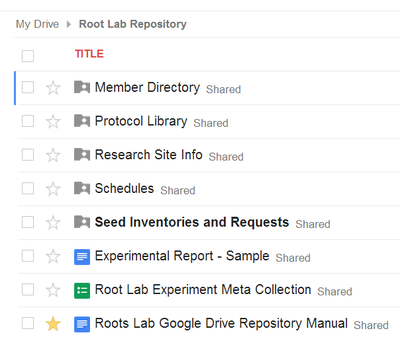Solving the problem of sad messes of drives and cables by doing experiment planning, data backup and sharing, and scheduling with an online lab repository.
Our lab has a secret drawer full of USB flash drives and external hard drives. In this sad mess of cables and plastic lies the final resting place of numerous graduate students' data, some of which was published and some of which remains orphaned. In a large lab, people come and go frequently, and it can be challenging to keep track of data and what lab members are working on.
We began using Google Drive in 2010 to share spreadsheets containing seed inventories and in 2011 for scheduling lab help. It was simpler than passing Excel files around or keeping a paper record. In order to solve the problems of data storage and dissemination, as well as the difficulties in keeping track of experiments being conducted in the lab, we decided to create an online lab repository in Google Drive. We quickly found more uses for it.
A lab Google account was created with its credentials known to the lab PI and the managing person. Within this lab account's Google Drive, one folder was created named Lab Repository. Lab members were added in the account's Gmail service and added to a Lab group. The Repository folder was shared with View privileges with the Lab group. Anything created within the Repository will inherit those permissions.

A spreadsheet was created within Repository called Experiment Meta Collection. Each row represents an experiment, with columns for the investigator, species studied, traits studied, treatments, location and a few other relevant fields. A form was created that users fill in to populate the collection spreadsheet. Only the Repository manager and Collection managers have edit privilege for this collection, so most members can only enter a new experiment through the form and view the spreadsheet to see what others are doing.
A Member Directory folder was added to the Repository, within which a folder was created for each lab member. By default, all lab members can view another member's folder and its contents. A particular lab member's folder had its ownership transferred to their Google account (an option in the item share dialog). Google Drive comes with 5 GB of data for each owner and additional data storage may be purchased. Being the owner, of course, gives full edit privileges, so each member's folder can only be edited by its owner and the Repository manager, but seen by everyone.
When a lab member wants to add a new experiment, they first create a folder for that experiment within their member folder. They then fill out a sample experimental report located in the root of the Repository and save it to that same folder. The experimental report contains detailed information about the experiment, initially for the plans for how to conduct it and some background, and eventually with a summary of results. They then fill out the form as described above to populate the Meta Collection and include a link to the experiment folder. Any data stored in the repository includes metadata describing the data, basic information about the experiment and a link to the report, how measurements were taken, and any calculations that were done.
Creating a Lab Repository with an online platform has made it easier to manage complex operations, to share and backup data, and has encouraged collaboration. Since the Repository's creation we've also added our entire protocol library and a folder for various schedules. Physical backups piled in depressing heaps in hidden drawers may not go away anytime soon, but at least they can stay hidden while we ascend to the cloud and get all Borg on it.
Contact Larry York for more information.

